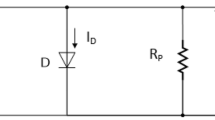Abstract
Unipolar and bipolar modulations are widely used in the active power filter of photovoltaic grid-connected inverter. In this paper, the basic modulation strategy, on–off action, influence of operational mode, harmonic current and efficiency of unipolar modulation are compared with the same of bipolar modulation. On this basis, a hybrid modulation strategy integrating advantages of unipolar and bipolar modulations is obtained after analysis, of which effectiveness and feasibility is verified in experiment.












Similar content being viewed by others
References
Al-Saedi, W., Lachowicz, S.W., Habibi, D.: (2011) An optimal current control strategy for a three-phase grid-connected photovoltaic system using particle swarm optimization. In: Power Engineering and Automation Conference. IEEE, pp. 286–290 (2011)
Zhou, T., Sun, W.: MPPT control method of PV system with PSO algorithm based on minimal particle angles. In: Proceedings of the 2012 International Conference on Information Technology and Software Engineering. Springer, Heidelberg, pp. 755–763 (2013)
Li, S.Q., Zhang, B., Xu, T.J., et al.: A new MPPT control method of photovoltaic grid-connected inverter system. In: Chinese Control and Decision Conference, pp. 2753–2757 (2014)
Wang, F., Zhang, C.: Protection and control for grid connected photovoltaic power generation system based on instantaneous power theory. In: Pacific-Asia Conference on Circuits, Communications and Systems, Paccs 2009, Chengdu, China, DBLP, pp. 356–359 (2009)
Zheng, L., Liu, S., Qinghe, X.U.: Constant power flow control at grid-connected point of photovoltaic microgrid based on nonlinear diffusion particle swarm optimization. Power Syst. Technol. 34(10), 152–156 (2010)
Mohammadi, H.R., Akhavan, A.: A new control method for grid-connected PV system based on quasi-Z-source cascaded multilevel inverter using evolutionary algorithm. Int. J. Power Electron. Drive Syst. 6(1), 109–120 (2015)
Welch, R., Venayagamoorthy, G.K.: A fuzzy-PSO based controller for a grid independent photovoltaic system. In: Swarm Intelligence Symposium, 2007. Sis. IEEE Xplore, pp. 227–233 (2007)
Hussain, T.N., Sulaiman, S.I., Musirin, I., et al.: A hybrid artificial neural network for grid-connected photovoltaic system output prediction. In: Computers & Informatics. IEEE, pp. 108–111 (2013)
Renaudineau, H., Donatantonio, F., Fontchastagner, J., et al.: A PSO-based global MPPT technique for distributed PV power generation. IEEE Trans. Ind. Electron. 62(2), 1047–1058 (2015)
Gómez, M., Jurado, F., Díaz, P., et al.: Evaluation of a particle swarm optimization based method for optimal location of photovoltaic grid-connected systems. Electr. Power Compon. Syst. 38(38), 1123–1138 (2010)
Souamy, L.: Research on the MPPT stability of the single-stage and single-phase photovoltaic grid-connected system. Appl. Mech. Mater. 263–266, 2252–2257 (2012)
Ebrahim, M.A., Abdelhadi, H.A., Mahmoud, H.M., et al.: Optimal design of MPPT controllers for grid connected photovoltaic array system. Int. J. Emerg. Electr. Power Syst. 17(5), 511–517 (2016)
Kornelakis, A.: Multiobjective particle swarm optimization for the optimal design of photovoltaic grid-connected systems. In: The, IEEE International Conference on Information Management and Engineering. IEEE, pp. 27–30 (2010)
Bhandari, B., Lee, K.T., Lee, G.Y., et al.: Optimization of hybrid renewable energy power systems: a review. Int. J. Precis. Eng. Manuf Green Technol. 2(1), 99–112 (2015)
Chen, L., Zhao, X.: Power control algorithm based on dynamic particle swarm optimization in cognitive radio networks. J. Comput. Inf. Syst. 11(8), 2863–2872 (2015)
Hamza, R., Muhammad, K., Arunkumar, N., González, G.: Hash based encryption for keyframes of diagnostic hysteroscopy. IEEE Access (2017). https://doi.org/10.1109/ACCESS.2017.2762405
Fernandes, S.L., Gurupur, V.P., Sunder, N.R., Arunkumar, N., Kadry, S.: A novel nonintrusive decision support approach for heart rate measurement. Pattern Recogn. Lett. (2017). https://doi.org/10.1016/j.patrec.2017.07.002
Arunkumar, N., Ramkumar, K., Venkatraman, V., Abdulhay, E., Fernandes, S.L., Kadry, S., Segal, S.: Classification of focal and non focal EEG using entropies. Pattern Recogn. Lett. 94, 112–117 (2017)
Arunkumar, N., Kumar, K.R., Venkataraman, V.: Automatic detection of epileptic seizures using new entropy measures. J. Med. Imaging Health Inform. 6(3), 724–730 (2016)
Arunkumar, N., Ram Kumar, K., Venkataraman, V.: Automatic detection of epileptic seizures using permutation entropy, Tsallis entropy and Kolmogorov complexity. J. Med. Imaging Health Inform. 6(2), 526–531 (2016)
Liu, S., Cai, C., Zhu, Q., Arunkumar, N.: A study of software pools for seismogeology-related software based on the Docker technique. Int. J. Comput. Appl. (2017). https://doi.org/10.1080/1206212X.2017.1396429
Author information
Authors and Affiliations
Corresponding author
Rights and permissions
About this article
Cite this article
Xiaoyu, C., Jianyong, Z. & Jun, M. Grid Connected Photovoltaic Power Generation Control Method Based on Swarm Intelligence Algorithm. Cluster Comput 22 (Suppl 2), 4491–4501 (2019). https://doi.org/10.1007/s10586-018-2047-9
Received:
Revised:
Accepted:
Published:
Issue Date:
DOI: https://doi.org/10.1007/s10586-018-2047-9




